The red fly agaric (Amanita muscaria) is one of the most colorful and well-known mushrooms, attracting attention with its bright red caps with white spots. Despite its reputation as a poisonous mushroom, in recent years it has become the object of close attention of scientists involved in alternative medicine and biohacking.
Main areas of application:
- Diseases of the nervous system
- Pain relief and analgesia
- Improving the quality of sleep
- Relieving muscle spasms
- Antidepressant effect
- Strengthening the immune system
- Psychoactive therapy
- Regulation of hormonal balance
- Antioxidant protection of cells
- Reducing inflammatory processes
Description of the mushroom
The red fly agaric is a medium-sized mushroom with a dense stem, topped with a characteristic bright red cap covered with white spots. The size of the cap varies from 8 to 20 cm in diameter. The hymenophore is lamellar, white in color, and the spore powder has a whitish tint. The cap is hemispherical when young, becoming flatter as it grows. Fly agaric is common in coniferous and deciduous forests, mainly in the temperate latitudes of the Northern Hemisphere. It is usually found under birch, pine and spruce trees, as it forms mycorrhizal associations with them. The mushroom prefers acidic soils and humid forests. The fruiting period occurs in late summer and autumn, but it can also be found in early winter, especially in regions with a mild climate. Despite its attractive appearance, it is known for its toxicity to humans. However, if processed correctly, it can be safe for use.

History of use in treatment
Red fly agaric has a long history of use in traditional medicine of various peoples of the world. In Siberia, it was used by shamans for ritual purposes, believing that the mushroom has the ability to open access to spiritual dimensions. In ancient cultures, its use is associated with the treatment of various mental and nervous disorders, including insomnia and depression. References to the medicinal properties of the fly agaric are found in ancient Roman and Greek sources. Shamans and healers used the fly agaric to relieve pain and relieve muscle tension. In traditional medicine of the indigenous peoples of North America, the mushroom was used to relieve fatigue and increase endurance. Some northern peoples used the fly agaric to treat colds and other respiratory diseases. In Tibet and Mongolia, the fly agaric was used to regulate the stomach and improve digestion. Despite its toxicity, in some cultures the mushroom was used as a pain reliever for wounds. In Indian medicine, the fly agaric was considered a remedy for infections. In Rus’, it was used to prepare tinctures that were used to treat joint pain and inflammation.
Active substances in the mushroom
The main bioactive substances in the fly agaric are alkaloids such as muscimol and ibotenic acid. These substances are the main psychoactive components of the mushroom. Muscimol is a potent agonist of GABA receptors, which makes it an important substance regulating the inhibitory processes in the central nervous system. Ibotenic acid is structurally similar to glutamic acid, which is an important neurotransmitter in the brain. However, ibotenic acid is converted into muscimol during metabolism, which explains its main psychoactive effect. In addition to these two substances, traces of other compounds such as muscazone and muscarine have been found in the fly agaric, which can also affect the nervous system, although their concentrations are much lower. Muscarine, despite its name, is not the main active substance of the fly agaric, but its toxic effects have been widely studied in the context of other mushroom species. Muscimol and ibotenic acid have a neurotoxic effect in large doses, but can have a therapeutic effect if taken in the right dose. The mushroom also contains β-carbolines, substances that are known for their antidepressant properties and ability to inhibit monoamine oxidase. These compounds play an important role in the metabolism of serotonin and other neurotransmitters. An important aspect is that the active substances of the fly agaric are destroyed by heat treatment, which reduces their toxicity. The fly agaric also contains many polysaccharides, such as chitin, which can have an immunomodulatory effect. The antioxidant properties of the mushroom are due to the presence of various phenolic compounds that protect cells from damage caused by free radicals.
Therapeutic effect for a biohacker
Red fly agaric attracts the attention of biohackers as a possible means for optimizing the body’s functioning. Initially, it should be noted that its use requires careful preparation and dosage to avoid intoxication. Muscimol, being a GABA receptor agonist, can have a sedative and relaxing effect. This makes it attractive to those looking for natural ways to combat anxiety and improve sleep. When taken in the right dose, fly agaric can help normalize circadian rhythms and improve sleep quality, which is essential for recovery and optimal brain function. Its antioxidant properties can also help slow down the aging process and reduce inflammatory reactions in the body. The polysaccharides of the mushroom can have a modulating effect on the immune system, improving its response to pathogens and protecting the body from infections. The mushroom has analgesic properties, which can be useful for chronic pain and inflammation in muscles and joints. An important aspect is the effect of fly agaric on mood regulation and cognitive function. Studies show that muscimol and other active substances in fly agaric can improve cognitive flexibility and the brain’s ability to adapt to new conditions. In some cases, fly agaric can be used to improve concentration and memory. Its psychoactive properties can be used for meditation and psychospiritual work. In small doses, fly agaric has a mild psychostimulant effect, which helps improve mood and energy. It can also reduce stress levels by having a relaxing effect on muscles and the nervous system.
In Canada, a few years ago, red toadstool (Amanita muscaria) was officially recommended for the production of food supplements. https://webprod.hc-sc.gc.ca/nhpid-bdipsn/searchIngred
Disclaimer:
The information provided in this article is for educational and informational purposes only. It is not intended as a substitute for professional medical advice, diagnosis, or treatment. Never disregard professional medical opinion and consult with a specialist.
Scientific articles:
Wagner A, Pehar M, Yan Z, Kulka M.
Zavadinack M, de Lima Bellan D, da Rocha Bertage JL, da Silva Milhorini S, da Silva Trindade E, Simas FF, Sassaki GL, Cordeiro LMC, Iacomini M.
Benkherouf AY, Taina KR, Meera P, Aalto AJ, Li XG, Soini SL, Wallner M, Uusi-Oukari M.
Crocq MA.
Akk G, Germann AL, Sugasawa Y, Pierce SR, Evers AS, Steinbach JH.






